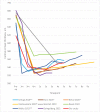Five-year clinical outcomes of 107 consecutive DMEK surgeries
- PMID: 38127965
- PMCID: PMC10735023
- DOI: 10.1371/journal.pone.0295434
Five-year clinical outcomes of 107 consecutive DMEK surgeries
Abstract
Purpose: The long-term clinical outcomes, postoperative complications, and graft survival of Descemet-membrane endothelial keratoplasty (DMEK) remain poorly understood. We retrospectively assessed these variables in all consecutive eyes that underwent DMEK for any indication in 2014-2018. The findings were compared to the long-term DMEK studies of five other groups (3-10-year follow-up).
Methods: Patients underwent ophthalmological tests preoperatively, at 1, 3, 6, and 12 postoperative months, and then annually. Five-year graft survival was determined by Kaplan-Meier estimator. Change in best-corrected visual acuity (BCVA), endothelial-cell density (ECD), and central-corneal thickness (CCT) at each timepoint was determined.
Results: 107 eyes (80 patients; 72 years old; 67% female) underwent first-time DMEK for uncomplicated Fuchs endothelial corneal dystrophy (94% of eyes), pseudophakic bullous keratopathy (3%), and regraft after previous keratoplasty (3%). The most common complication was graft detachment requiring rebubbling (18%). Thirteen grafts (12%) failed at ≤15 months. Cumulative 5-year graft-survival probability was 88% (95% confidence intervals = 79-94%). BCVA improved from 0.6 logMAR preoperatively to 0.05 logMAR at 1 year (p<0.0001) and then remained stable. Donor ECD dropped by 47% at 6 postoperative months and then continued to decrease by 4.0%/year. Five-year endothelial-cell loss was 65% (from 2550 to 900 cells/mm2). CCT dropped from 618 to 551 μm at 5 years (p<0.0001). These findings are generally consistent with previous long-term DMEK studies.
Conclusions: DMEK has low complication and high graft-survival rates and excellent clinical outcomes that persist up to 5 years post-surgery. DMEK seems to be a safe and effective treatment in the long term.
Copyright: © 2023 Bichet et al. This is an open access article distributed under the terms of the Creative Commons Attribution License, which permits unrestricted use, distribution, and reproduction in any medium, provided the original author and source are credited.
Conflict of interest statement
The authors have declared that no competing interests exist.
Figures








References
-
- Fuchs E. Dystrophia epithelialis corneae. Graefes Arhiv für Ophthalmologie. 1910;76: 478–508.
MeSH terms
LinkOut - more resources
Full Text Sources

